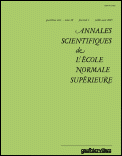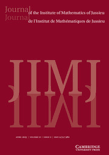
ANNALES SCIENTIFIQUES DE L ECOLE NORMALE SUPERIEURE
Scope & Guideline
Connecting Ideas, Inspiring Discoveries in Mathematics
Introduction
Aims and Scopes
- Algebraic Geometry and Algebraic Topology:
The journal frequently publishes articles exploring the structures and properties of algebraic varieties, schemes, and their topological implications, contributing significantly to the understanding of modern algebraic geometry. - Differential Geometry and Geometric Analysis:
Research in this area includes the study of manifolds, curvature, and geometric flows, often employing tools from analysis to address geometric problems, thereby enriching both fields. - Representation Theory and Group Theory:
The journal covers advancements in the representation theory of groups, particularly in the context of algebraic groups and quantum groups, often linking these concepts to number theory and algebraic geometry. - Partial Differential Equations (PDEs) and Dynamical Systems:
Many articles focus on the existence, regularity, and qualitative behavior of solutions to various PDEs, as well as their applications in dynamical systems, showcasing the interplay between analysis and geometry. - Mathematical Physics:
This scope includes the application of mathematical methods to solve physical problems, with an emphasis on quantum mechanics, statistical mechanics, and the mathematical foundations of physical theories.
Trending and Emerging
- Higher Dimensional Algebraic Geometry:
There is a growing trend towards exploring higher-dimensional algebraic varieties and their properties, reflecting an increasing interest in the geometric aspects of algebraic structures. - Nonlinear Partial Differential Equations:
Recent articles have increasingly focused on the study of nonlinear PDEs, particularly in the context of geometric analysis and their implications in mathematical physics, indicating a vibrant area of research. - Categorical and Homological Algebra:
Emerging themes include the application of category theory and homological methods to solve problems in various areas of mathematics, highlighting a shift towards abstract and structural approaches. - Quantum Geometry and Topological Quantum Field Theory:
The intersection of quantum theory with geometric structures is becoming more prominent, with research delving into the mathematical foundations of quantum field theories and their geometrical interpretations. - Stability and Rigidity in Dynamical Systems:
There is an increasing focus on the stability properties of dynamical systems, particularly within the realm of Anosov flows and their generalizations, indicating a rich area of ongoing investigation.
Declining or Waning
- Classical Mechanics and Traditional Physics:
There has been a noticeable decline in articles related to classical mechanics and traditional physics, as the journal shifts towards more modern and abstract mathematical frameworks. - Elementary Number Theory:
Papers specifically focused on elementary number theory have decreased, with a shift towards more complex interactions between number theory and algebraic geometry or arithmetic geometry. - Basic Topology:
The focus on fundamental topological concepts seems to be diminishing, as researchers are now leaning towards more sophisticated and interrelated topological structures and their applications.
Similar Journals

Mediterranean Journal of Mathematics
Pioneering New Paths in Mathematics Since 2004The Mediterranean Journal of Mathematics, published by SPRINGER BASEL AG, is a prominent platform dedicated to the advancement of mathematical research and education. Since its inception in 2004, this journal has been pivotal in disseminating high-quality research across various fields of mathematics, currently holding a notable Q2 ranking in the miscellaneous mathematics category as of 2023. With its ISSN 1660-5446 and E-ISSN 1660-5454, the journal enjoys a respected position in the academic community, evident by its Scopus rank of 129 out of 399 in General Mathematics, placing it in the 67th percentile. While primarily a subscription-based journal, it remains committed to providing a comprehensive resource for researchers, professionals, and students, fostering dialogue and exploration within the mathematical sciences. The Mediterranean Journal of Mathematics, based in Basel, Switzerland, continues to contribute significantly to the evolution of mathematical theory and practice, marking its relevance as we approach its 20th anniversary in 2024.

CANADIAN JOURNAL OF MATHEMATICS-JOURNAL CANADIEN DE MATHEMATIQUES
Fostering collaboration and innovation in mathematics.Canadian Journal of Mathematics - Journal Canadien de Mathématiques is a prestigious peer-reviewed journal published by Cambridge University Press, which aims to advance the field of mathematics through the dissemination of high-quality research articles. With its ISSN 0008-414X and E-ISSN 1496-4279, the journal plays a pivotal role in fostering mathematical research and collaboration. It has been recognized for its impactful contributions, currently holding a category quartile ranking of Q2 in Mathematics (miscellaneous) for 2023 and sits in the 66th percentile among its peers according to Scopus rankings. As the journal continues its convergence from its inception in 1994 through to 2024, it remains a vital resource for researchers, professionals, and students seeking to stay at the forefront of mathematical developments. The journal does not operate under an open access model, allowing for a curated collection of articles that adhere to rigorous academic standards.

PUBLICACIONS MATEMATIQUES
Illuminating the World of MathematicsPUBLICACIONS MATEMATIQUES is a prestigious academic journal published by Universitat Autònoma de Barcelona, specializing in the diverse field of mathematics and its applications. With an esteemed Q1 ranking in Mathematics (miscellaneous) for 2023, this journal holds a significant position in the mathematical community, reflecting a commitment to high-quality research that spans both theoretical and practical aspects of mathematics. Although it operates without an Open Access model, it remains accessible to a global audience, featuring contributions that range from pure mathematical theories to interdisciplinary applications. Based in Spain, its influence and reach extend internationally, making it a vital resource for researchers, professionals, and students alike who seek to stay informed and engaged with cutting-edge developments in mathematics. The journal's continuous publication since 2002 further underscores its role in advancing mathematical research and fostering scholarly dialogue.

MANUSCRIPTA MATHEMATICA
Championing High-Quality Research in Mathematics.MANUSCRIPTA MATHEMATICA is an esteemed journal in the field of mathematics, published by Springer Heidelberg. Since its inception in 1969, this journal has served as a pivotal platform for disseminating high-quality research in a variety of mathematical disciplines, with a commitment to advancing knowledge and fostering collaboration among mathematicians. The journal holds a commendable impact factor and is ranked within the Q2 category for Mathematics (miscellaneous) in 2023, placing it favorably among its peers in terms of academic influence. Although open access options are not available, its rigorous peer-review process ensures that published articles maintain the highest academic standards. With a wide scope covering significant areas of general mathematics, MANUSCRIPTA MATHEMATICA not only caters to researchers and professionals seeking innovative insights but also serves as a valuable resource for students eager to deepen their understanding of mathematical theories and applications. For those looking to contribute to or stay informed about advancements in this dynamic field, the journal remains a crucial resource for literature and discourse.

PUBLICATIONES MATHEMATICAE DEBRECEN
Bridging Theory and Application in MathematicsPublicationes Mathematicae Debrecen is a renowned international journal published by the University of Debrecen, Institute of Mathematics, situated in Hungary. This journal, with both ISSN 0033-3883 and E-ISSN 2064-2849, has established itself in the field of mathematics since its inception, with coverage extending from 1997 to 2024. Recognized for its rigorous academic standards, it currently holds a Q3 ranking in the mathematics (miscellaneous) category for 2023 and ranks at the 42nd percentile among general mathematics journals in Scopus. Publicationes Mathematicae Debrecen aims to disseminate high-quality research across various areas of mathematics, contributing to the advancement of knowledge and practice in this dynamic field. Although it is not an open-access journal, its readers can access a wealth of scholarly work that addresses both theoretical and applied mathematical issues, making it an invaluable resource for researchers, professionals, and students alike.

Milan Journal of Mathematics
Fostering a vibrant community of mathematical thinkers.Milan Journal of Mathematics is a prestigious academic publication dedicated to advancing the field of mathematics, particularly in the miscellaneous areas of the discipline. Published by SPRINGER BASEL AG in Switzerland, this journal has established a strong impact in the academic community, noted for its Q1 ranking in Mathematics and achieving a commendable 80th percentile in the Scopus rankings. With an ISSN of 1424-9286 and E-ISSN 1424-9294, the journal serves as a crucial platform for researchers and scholars to disseminate their findings and engage with cutting-edge mathematical theories and applications. Although not an Open Access publication, it provides valuable insights and rigorous academic discourse for professionals, researchers, and students alike, fostering a rich environment for knowledge exchange and innovation in mathematics.

Journal of the Institute of Mathematics of Jussieu
Connecting Scholars Through Cutting-edge Mathematical ResearchJournal of the Institute of Mathematics of Jussieu, published by Cambridge University Press, is a leading academic journal that has established itself as a vital resource in the field of mathematics. With an impressive impact factor and a ranking in the top quartile (Q1) of miscellaneous mathematics, the journal serves as a platform for high-quality research from both established scholars and emerging researchers. Spanning from 2002 to 2024, the journal aims to foster collaboration and innovation in the mathematical community by publishing original research articles, reviews, and critical discussions on a wide range of mathematical topics. Although the journal does not offer open access, it remains widely accessible through various academic institutions and libraries, ensuring that critical advancements in mathematics are shared with a global audience. Located in the United Kingdom at the prestigious Cambridge campus, the journal reflects the rigorous standards of its publisher and the rich academic tradition of its home institution.

European Journal of Mathematics
Bridging Theory and Practice in MathematicsWelcome to the European Journal of Mathematics, a prominent publication that serves as a vital platform for disseminating high-quality research in the field of mathematics. Published by Springer International Publishing AG, this journal has witnessed significant growth since its inception in 2015 and is recognized for its contributions within the Q2 category of Mathematics (miscellaneous) as per the 2023 rankings. With an ISSN of 2199-675X and an E-ISSN of 2199-6768, the journal aims to foster innovation and collaboration among researchers, professionals, and students alike. Although it operates under a traditional access model, the journal's commitment to advancing mathematical knowledge and applications cannot be overstated. Positioned among the top-tier publications, the European Journal of Mathematics is an essential resource that encourages the exploration of emerging trends and theories in mathematics, making it indispensable for anyone striving to stay at the forefront of this dynamic field.

ANNALS OF MATHEMATICS
Innovating Solutions through Rigorous ResearchANNALS OF MATHEMATICS is a prestigious peer-reviewed journal published by the Department of Mathematics at Princeton University, dedicated to the advancement of mathematical research across diverse fields, including mathematics, statistics, and probability. With an impressive impact factor reflecting its critical role in the academic community, this journal is categorized within the Q1 quartile rankings for both Mathematics and Statistics in 2023, evidencing its high circulation of influential and often-cited publications. Researchers can access the latest findings and theoretical advancements in an environment that fosters intellectual discourse and innovation, although the journal does not currently offer open access. Spanning a remarkable convergence period from 1996 to 2024, the ANNALS OF MATHEMATICS serves as a vital resource for mathematicians, statisticians, and analysts striving to push the boundaries of knowledge and application in these critical fields.

FORUM MATHEMATICUM
Illuminating the Path of Mathematical InquiryFORUM MATHEMATICUM, published by WALTER DE GRUYTER GMBH, is a distinguished academic journal based in Germany, known for its significant contributions to the field of mathematics. With an ISSN of 0933-7741 and an E-ISSN of 1435-5337, the journal features comprehensive studies ranging from applied mathematics to diverse mathematical disciplines. Having maintained a commendable presence since 1989, FORUM MATHEMATICUM has achieved notable classification rankings, including Q2 in Applied Mathematics and Q1 in miscellaneous Mathematics as of 2023. Additionally, it holds a Scopus rank within the top 60th percentile in General Mathematics, making it a prominent platform for researchers and professionals seeking rigorous analysis and innovative methodologies in mathematics. While the journal does not currently offer open access, its rich content is pivotal for advancing mathematical theory and applications, appealing to students and seasoned academics alike.